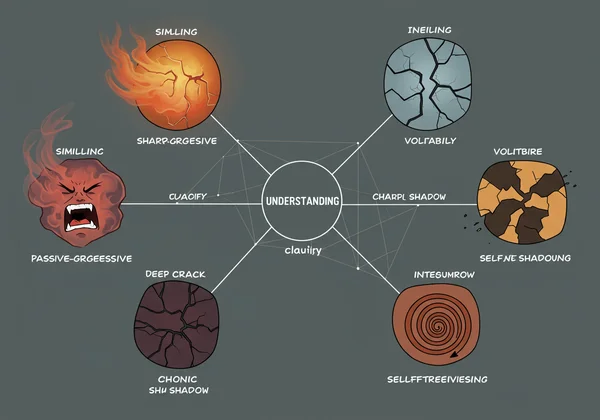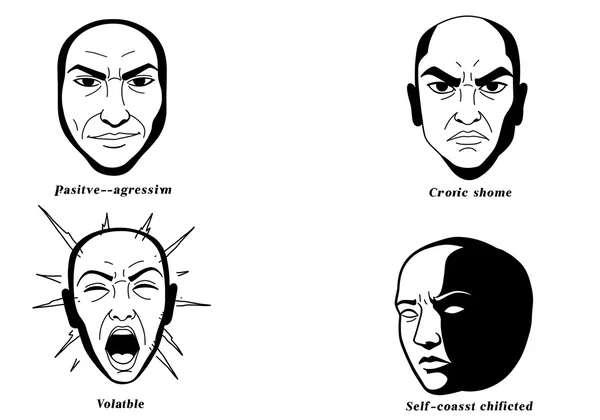The Different Types of Anger: Understanding Your Rage
Have you ever felt anger that simmers just beneath the surface, showing up as sarcasm or silent treatment? Or perhaps you've experienced explosive outbursts that seem to come from nowhere, leaving you and others reeling. Anger isn't a one-size-fits-all emotion; it manifests in a rich variety of ways. How do I know if I have anger issues or a specific type of anger? Understanding these different types of anger is the first, most crucial step towards gaining self-awareness, fostering healthier emotional responses, and mastering your reactions.
This article will guide you through the common ways anger shows up. By learning to identify your own patterns, you can move from being controlled by your emotions to understanding them. This understanding can help you improve your emotional health. If you're ready to begin this journey of self-exploration, a great place to start is with a free anger test designed to offer personal insights.

Why Understanding Anger Types Matters for Self-Growth
Simply knowing that you feel "angry" is not enough for meaningful change. True insight comes from breaking down this emotion to see how it uniquely affects you. This deeper awareness is fundamental to personal development and effective emotional regulation.
Beyond Just "Being Angry": The Nuances of Emotional Expression
Labeling your emotion simply as "anger" is like describing all music as just "sound." It misses the rich detail—the rhythm, the tempo, the melody. When you can pinpoint whether your anger is passive-aggressive, chronic, or volatile, you gain a more precise understanding of your internal world. When you're clear on how your anger expresses itself, you can pinpoint specific triggers and underlying causes that you might otherwise overlook. Are you feeling resentful due to unmet expectations (chronic anger) or are you using sarcasm to avoid direct conflict (passive-aggressive anger)? Each requires a different approach.
The First Step Towards Effective Anger Management
Managing anger starts with understanding it. Recognizing your dominant anger type is the foundational step toward developing targeted coping strategies. Techniques for cooling down an explosive outburst are very different from methods needed to address the deep-seated resentment of chronic anger. By identifying your pattern, you can search for and apply the most effective anger management techniques for your specific situation, rather than using a generic approach that may not work. This self-knowledge empowers you to take control and respond to situations with intention instead of instinct.
Exploring Common Manifestations: Key Anger Types
Anger can wear many masks. Some are loud and obvious, while others are quiet and insidious. Let's explore some of the most common ways anger manifests, which can help you start to identify your own emotional landscape. As you read, see which descriptions resonate most with your experiences.

Passive-Aggressive Anger: The Silent Burn
Passive-aggressive anger is indirect hostility. Instead of expressing frustration openly, a person might resort to subtle actions designed to frustrate or annoy others. This can include giving someone the silent treatment, making sarcastic "jokes" at their expense, procrastinating on important tasks, or feigning ignorance to avoid responsibility. This passive aggressive anger often stems from a fear of direct confrontation but can be incredibly damaging to relationships, as it erodes trust and prevents open communication.
Chronic Anger: Living with Lingering Fury
Chronic anger is a prolonged state of resentment, irritability, and frustration. It’s like a low-grade fever for your emotions—always present in the background. Someone with chronic anger may feel perpetually wronged by the world, hold onto grudges for years, and have a generally cynical outlook. This lingering fury can have serious consequences for both mental and physical health, contributing to stress, high blood pressure, and a weakened immune system. It often reflects deep, unresolved issues that continue to fuel a sense of injustice.
Volatile Anger: Explosive Outbursts and Their Impact
This is the type of anger most people picture: sudden, intense, and often destructive outbursts. Volatile anger, sometimes called explosive anger, involves yelling, shouting, throwing objects, or even physical aggression. The reaction is typically far out of proportion to the trigger. This form of anger can be terrifying for those on the receiving end and deeply shameful for the person experiencing it afterward. It significantly damages personal and professional relationships, creating an environment of fear and instability. An anger issues test can often help pinpoint the intensity and frequency of these outbursts.
Self-Inflicted Anger: When Rage Turns Inward
Not all anger is directed outward. Sometimes, it is turned inward, manifesting as harsh self-criticism, immense guilt, or feelings of worthlessness. This self-inflicted anger involves punishing yourself for perceived mistakes or shortcomings. You might constantly tell yourself you're "not good enough" or engage in negative self-talk that you would never direct at another person. This pattern is closely linked to low self-esteem, anxiety, and depression, creating a painful internal cycle of shame and rage.
Differentiating Anger Expression: Healthy vs. Destructive Patterns
It's important to remember that anger itself isn't 'bad.' In fact, healthy anger can be a powerful and positive force. It can signal that a boundary has been crossed, an injustice has occurred, or a need is not being met. When expressed constructively, it can motivate you to solve problems, stand up for yourself, and create positive change. The key is differentiating healthy from destructive anger expression. Destructive patterns harm you or others, while healthy expression seeks resolution and respects boundaries.
Your Journey to Emotional Well-being Starts Here
Identifying your tendencies from the descriptions above is an excellent starting point. However, human emotions are complex, and you may see parts of yourself in several categories. The next step is to gain a more personalized and structured understanding of your unique anger profile.
How a Multidimensional Anger Test Can Provide Clarity
This is where a scientifically-grounded assessment tool can be incredibly valuable. A multidimensional anger test doesn't just ask "are you angry?" Instead, it explores the different facets of your anger, including its frequency (how often you feel it), its intensity (how strong it is), its duration (how long it lasts), and its expression (how you show it). This detailed feedback provides a much clearer picture of your emotional landscape. Taking an online anger assessment can help you connect the dots and see your patterns more objectively.
Moving Forward: From Understanding to Action
Knowledge is only powerful when it leads to action. Once you have a better understanding of your anger, you can begin the work of managing it effectively. This journey starts with the brave step of honest self-assessment. Understanding the different types of anger is an empowering act of self-discovery. By moving beyond a simple "I'm angry" label and recognizing whether your anger is passive-aggressive, chronic, volatile, or self-inflicted, you gain the precise knowledge needed to manage it effectively. This clarity illuminates your triggers, paving the way for stronger relationships.
You have already taken the first step by seeking this knowledge. Now, take the next one. Take a free, scientifically-backed anger test to gain personalized insights. It is designed to provide you with a clearer picture of your unique anger profile, helping you start your self-discovery and begin your path toward greater emotional control and well-being today.

Frequently Asked Questions About Anger Types & Assessment
What is the primary difference between anger and rage?
Anger is a natural human emotion that can range from mild annoyance to intense frustration. It's a signal. Rage, on the other hand, is an intense, often uncontrollable state of anger where a person may lose control of their actions and reasoning. While anger is the emotion, rage is its most extreme and often destructive expression.
How do I know if I have anger issues or a specific type of anger?
Reflecting on how anger impacts your life is a good start. Does it negatively affect your relationships, work, or health? Do you see a recurring pattern in how you react? For a more objective perspective, a confidential and structured tool like an online anger test can provide valuable insights by analyzing your responses against established psychological models.
Can an online anger test diagnose me with an anger disorder?
No, and this is a critical point. Online tools like our scientifically-backed anger test are for informational and self-exploration purposes only. They can help you understand your emotional patterns but cannot provide a medical diagnosis. A formal diagnosis for a condition like Intermittent Explosive Disorder must be made by a qualified mental health professional, such as a psychologist or psychiatrist.
What are the signs of passive-aggressive anger in relationships?
Common signs include frequent sarcasm, giving the silent treatment, "forgetting" to do things you've agreed to, making subtle jabs disguised as jokes, and a general reluctance to be direct about problems. The person may deny they are angry while their actions clearly communicate hostility.
Can anger ever be a healthy emotion?
Yes, healthy anger can be a powerful internal alert system. It can signal that your values have been violated, your boundaries have been crossed, or you are facing an injustice. When harnessed constructively, this anger can motivate you to stand up for yourself, solve problems, and create positive change in your life and the world around you.